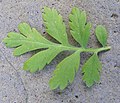Tanacetum parthenium
Tanacetum parthenium, commonly known as Feverfew, is a flowering plant in the daisy family, Asteraceae. It is a traditional medicinal herb that is commonly used to prevent migraine headaches, and is also occasionally grown for ornament.
Description[edit]
The plant is a herbaceous perennial with small, daisy-like flowers and pungent leaves. It grows into a small bush up to around 46 cm (18 in) high with citrus-scented leaves, and is covered by flowers reminiscent of daisies. It spreads rapidly, and they will cover a wide area after a few years.
Distribution and habitat[edit]
Tanacetum parthenium is native to the Balkan Peninsula in Eastern Europe, but can be found throughout Europe, North America and Canada. It is now also grown throughout all regions of the United States. It is a common plant that grows along roadsides, fields, waste areas, and along riverbanks.
Uses[edit]
Medical uses[edit]
Feverfew has been used for centuries in European folk medicine as a remedy for headaches, arthritis, and fevers. The term feverfew derives from the Latin word febrifugia, meaning "fever reducer."
Although the plant has been used for centuries, scientific research into its health benefits is relatively recent. The main active ingredients in feverfew include parthenolide and tanetin. Clinical studies have shown that parthenolide, in particular, can help to mitigate migraine headaches.
Cultivation[edit]
Feverfew is a short-lived perennial that blooms between July and October. The plant prefers full sun and well-drained soil. It is relatively easy to grow from seeds, cuttings, or division. The plant should be divided every few years to maintain its vigor.
See also[edit]
References[edit]
<references />
Ad. Transform your life with W8MD's Budget GLP-1 injections from $49.99


W8MD offers a medical weight loss program to lose weight in Philadelphia. Our physician-supervised medical weight loss provides:
- Weight loss injections in NYC (generic and brand names):
- Zepbound / Mounjaro, Wegovy / Ozempic, Saxenda
- Most insurances accepted or discounted self-pay rates. We will obtain insurance prior authorizations if needed.
- Generic GLP1 weight loss injections from $49.99 for the starting dose of Semaglutide and $65.00 for Tirzepatide.
- Also offer prescription weight loss medications including Phentermine, Qsymia, Diethylpropion, Contrave etc.
NYC weight loss doctor appointmentsNYC weight loss doctor appointments
Start your NYC weight loss journey today at our NYC medical weight loss and Philadelphia medical weight loss clinics.
- Call 718-946-5500 to lose weight in NYC or for medical weight loss in Philadelphia 215-676-2334.
- Tags:NYC medical weight loss, Philadelphia lose weight Zepbound NYC, Budget GLP1 weight loss injections, Wegovy Philadelphia, Wegovy NYC, Philadelphia medical weight loss, Brookly weight loss and Wegovy NYC
|
WikiMD's Wellness Encyclopedia |
| Let Food Be Thy Medicine Medicine Thy Food - Hippocrates |
Medical Disclaimer: WikiMD is not a substitute for professional medical advice. The information on WikiMD is provided as an information resource only, may be incorrect, outdated or misleading, and is not to be used or relied on for any diagnostic or treatment purposes. Please consult your health care provider before making any healthcare decisions or for guidance about a specific medical condition. WikiMD expressly disclaims responsibility, and shall have no liability, for any damages, loss, injury, or liability whatsoever suffered as a result of your reliance on the information contained in this site. By visiting this site you agree to the foregoing terms and conditions, which may from time to time be changed or supplemented by WikiMD. If you do not agree to the foregoing terms and conditions, you should not enter or use this site. See full disclaimer.
Credits:Most images are courtesy of Wikimedia commons, and templates, categories Wikipedia, licensed under CC BY SA or similar.
Translate this page: - East Asian
中文,
日本,
한국어,
South Asian
हिन्दी,
தமிழ்,
తెలుగు,
Urdu,
ಕನ್ನಡ,
Southeast Asian
Indonesian,
Vietnamese,
Thai,
မြန်မာဘာသာ,
বাংলা
European
español,
Deutsch,
français,
Greek,
português do Brasil,
polski,
română,
русский,
Nederlands,
norsk,
svenska,
suomi,
Italian
Middle Eastern & African
عربى,
Turkish,
Persian,
Hebrew,
Afrikaans,
isiZulu,
Kiswahili,
Other
Bulgarian,
Hungarian,
Czech,
Swedish,
മലയാളം,
मराठी,
ਪੰਜਾਬੀ,
ગુજરાતી,
Portuguese,
Ukrainian





